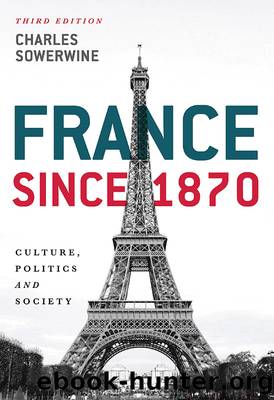France since 1870 by Charles Sowerwine

Author:Charles Sowerwine [Sowerwine, Charles]
Language: eng
Format: epub
Tags: History, Europe, General, France, Modern
ISBN: 9781137406118
Google: 2-xIDwAAQBAJ
Publisher: Bloomsbury Publishing
Published: 2018-01-25T15:59:24+00:00
The Politics of âGrandeurâ: Urbanism and Culture
De Gaulleâs instincts for âgrandeurâ led him to support urban policy initiatives, which preserved much of the integrity of Paris and other French cities, preventing American-style development from cluttering the great spaces of which the French were justly so proud.
De Gaulle was aware of the influence among intellectuals of an argument for decentralization, advanced most famously by Jean Gravier in a 1947 book, Paris et le désert français (Paris and the French Desert), which was republished to acclaim in 1958. If France outside Paris was not quite a âdesertâ, Paris did obtain the lionâs share of infrastructure support. The Fifth Republic sought to provide balance, first by setting up, on 14 February 1963, a bureaucracy for regional economic development and then, a year later, creating 21 regions, each under a super-prefect and grouping several of the 90 departments which had hitherto been the largest administrative units. The boundaries of these regions became the basis of the 1982 decentralization.
The regions were a response to the first stirrings of regionalism among Bretons, Basques and Occitans, as the southerners who wished greater autonomy for the Midi called themselves. Bretons had a traditional identity developed around their resistance to the great Revolution. Basques in southwest France picked up separatist ideas from Basques across the border fighting General Francoâs fascist regime (which continued to rule Spain until Francoâs death in 1975). Southerners in the Midi (the area between Marseille and Aix-en-Provence) constructed a regional identity out of disparate precedents and joined the push for greater autonomy.
De Gaulleâs ideal of the strong state precluded major concessions to regionalism. In fact, the main thrust of his time in office was to reinforce Parisâ position as the pre-eminent site for the display of French culture and âgrandeurâ. The Paris region had been governed as one department, the Seine, for a century and a half. This department, theoretically one of 90, by 1962 accounted for nearly 6 million people, one-eighth of the national population. De Gaulle appointed a powerful planner for the Paris region and legislated to restructure its governance. In 1968, the City of Paris became a department on its own. The suburbs around Paris became three new departments. The formerly rural departments on to which the suburbs were now encroaching were reorganized and two more new departments created. The numbers of the departments listed alphabetically have long been part of French life, used for telephone numbers, postcodes and automobile number plates, though their use has diminished as a result of regionalisation. Paris proper retained the famous 75 for the Seine. The five new departments â three suburban and two formerly rural â became 91 to 95. The whole Paris conurbation â roughly the old Ãle-de-France, the territory of the Counts of Paris 1000 years ago â was given a regional plan and a regional prefect.
Four new towns were set up on the outskirts of Paris as poles for intense resi-dential and industrial development. To relieve the demands of business for modern
Download
This site does not store any files on its server. We only index and link to content provided by other sites. Please contact the content providers to delete copyright contents if any and email us, we'll remove relevant links or contents immediately.
| Africa | Americas |
| Arctic & Antarctica | Asia |
| Australia & Oceania | Europe |
| Middle East | Russia |
| United States | World |
| Ancient Civilizations | Military |
| Historical Study & Educational Resources |
Machine Learning at Scale with H2O by Gregory Keys | David Whiting(4178)
Never by Ken Follett(3790)
Fairy Tale by Stephen King(3220)
The Man Who Died Twice by Richard Osman(2997)
Oathbringer (The Stormlight Archive, Book 3) by Brandon Sanderson(2877)
Will by Will Smith(2792)
Rationality by Steven Pinker(2291)
The Dark Hours by Michael Connelly(2243)
Can't Hurt Me: Master Your Mind and Defy the Odds - Clean Edition by David Goggins(2225)
The Dawn of Everything: A New History of Humanity by David Graeber & David Wengrow(2122)
Friends, Lovers, and the Big Terrible Thing by Matthew Perry(2119)
Principles for Dealing With the Changing World Order: Why Nations Succeed and Fail by Ray Dalio(1973)
HBR's 10 Must Reads 2022 by Harvard Business Review(1776)
A Short History of War by Jeremy Black(1762)
Go Tell the Bees That I Am Gone by Diana Gabaldon(1687)
515945210 by Unknown(1599)
A Game of Thrones (The Illustrated Edition) by George R. R. Martin(1588)
Kingdom of Ash by Maas Sarah J(1523)
443319537 by Unknown(1470)
